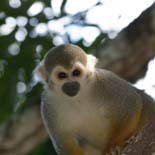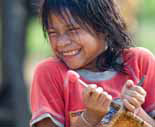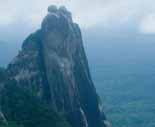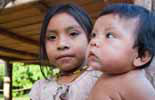 |
 |
 |
|
|||||||||||||||||
Suriname
With a population under 500,000 as of mid-2007 and projections indicating little demographic change for the next fifty years, Suriname still has more than 95% of the country's habitat in a virtually untouched situation. That's 38 million acres of wilderness, or the equivalent of more than six Yellowstone National Parks. It is the size of Wisconsin or Bangladesh or 163,265 square kilometers.
This is where Conservation International President Dr. Russell A. Mittermeier did his Ph.D. dissertation back in the mid-1970s while a graduate student at Harvard. While studying several native primates here, he fell in love with the country. CI's long-time commitment to Suriname, both financially and scientifically, has helped maintain and document what is the core area in the largest remaining tropical rainforest expanse on Earth: the Guyana Shield. This geologically-unique area encompasses not only the vast majority of Suriname, but also upper Amazonian forest spread contiguously across some six hundred thousand square kilometers of Amapa State in northern Brazil, French Guyana, Guyana and parts of Columbia and Venezuela.
While in Suriname to profile some of its remarkable and creative biodiversity conservation for Sanctuary: Global Oases of Innocence, DSF was hosted by Dr. Mittermeier and CI staff, including Conservation International's Executive Director for Suriname, The Honorable Wim Udenhout, former Prime Minister of Suriname and Ambassador to the U.S. among many other nations.
Dr. Mittermeier was in Suriname to meet with a tribal chief in the far South to persuade him and his peers of the wisdom of setting aside a large tract of forest in their domain, along the Brazilian border. His argument comports with that of all conservationists today who attempt to facilitate practical ways of compensating governments and indigenous people for maintaining their precious habitat. Countries like Suriname proffer a lure for multinationals seeking to become carbon neutral: incredible forests, unique species and a rich and diverse cultural heritage. All that Suriname asks in return for conserving its forests is a revenue stream to mitigate any adverse economic pressures within the country. That in situ, carbon-neutralizing formula needs to be realized, or grown into a global strategy with the same market base as other forms of equity.
The Trio Amerindian Chief that Dr. Mittermeier met with seemed to agree. So does the country's Minister of Physical Land Planning and Forestry, Dr. M. John Tjie Fa, with whom we met at the research and eco-tourist camp of Raleigh Vallen, a region of small cataracts in the jungle named after the great Renaissance explorer Sir Walter Raleigh. Raleigh tried to find this place, and was said to have thought it to be the original Garden of Eden.
Given that this is one of the largest standing great tropical rain forests on the planet, its Central Nature Reserve all but uninhabited; with more fresh water per capita than any other country (and the cleanest water, at that); and that these tropics host a known 722 birds, 185 mammals, 152 reptiles, 95 amphibians, and 790 fish species, of which about 3% are endemic - Raleigh was not mistaken. Donors, NGOs, conservationists and governments everywhere need to help Suriname maintain this precious jewel which she has duly enshrined.CI-Suriname, and the Central Suriname Nature Reserve
http://www.conservation.org/EXPLORE/SOUTH_AMERICA/SURINAME/Pages/suriname.aspx
http://www.conservation.org/newsroom/pressreleases/Pages/suriname_bold_plan.aspx





